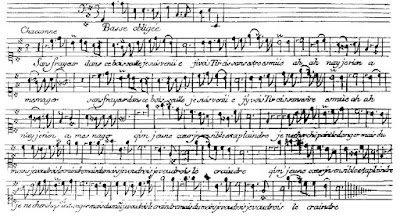 |
| Marc-Antoine Charpentier (probably) |
First let's start with a performance of the piece, a chaconne for voice and continuo by Marc-Antoine Charpentier. This is "Sans frayeur dans ce bois" performed by Lea Desandre and Thomas Dunford and yes, I have posted it before, but stick with me, this might get interesting.
Yes, that's correct, every single thing you hear, apart from those simple bass notes, was invented by Dunford. Was it improvised? Certainly the first couple of times, but by the time they got to the recording studio I'm sure he had settled on what he was going to do. Here is the complete score, the rest is the vocal part:
 |
| Click to enlarge |
Now I am quite familiar with this sort of thing as I have played lots of lute duets written in a similar fashion. Here is a piece by John Johnson for lute duet titled "The Queen's Dump." The accompanying musician (I think she is playing an orpharion) keeps playing the same simple chord progression, but when I played it I only did that a couple of times and then started strumming, changing the rhythm, doing everything I could to change it up. I can't find anything like that on YouTube, and sadly we never recorded it, but trust me, it is the thing to do!
I love that they changed the title to something less suggestive, but I transcribed it from a photostat of the original manuscript, Jane Pickering's Lute Book, and the title is "The Queen's Dump." A dump was a kind of dance in the 16th century.
I think this is the ground to The Queen's Dump, but it is not labeled as such in this manuscript, but whether it is or not, it shows you what the original notation looks like, French lute tablature.
 |
| Click to enlarge |
And here is my transcription of the ground to The Queen's Dump:
I take a very tiny amount of credit for doing some wild, improvisatory accompaniments in these kinds of pieces (there are lots of other examples) twenty and thirty years ago, but only a very tiny amount because, of course, the musicians of the 16th and 17th centuries were doing it all the time.
Now go back and listen to Desandre and Dunford one more time and groove on the inégale.



2 comments:
Wow, Thomas Dunford actually swings, I'm impressed!
Yeah, he's great! And they are a lovely duo.
Post a Comment